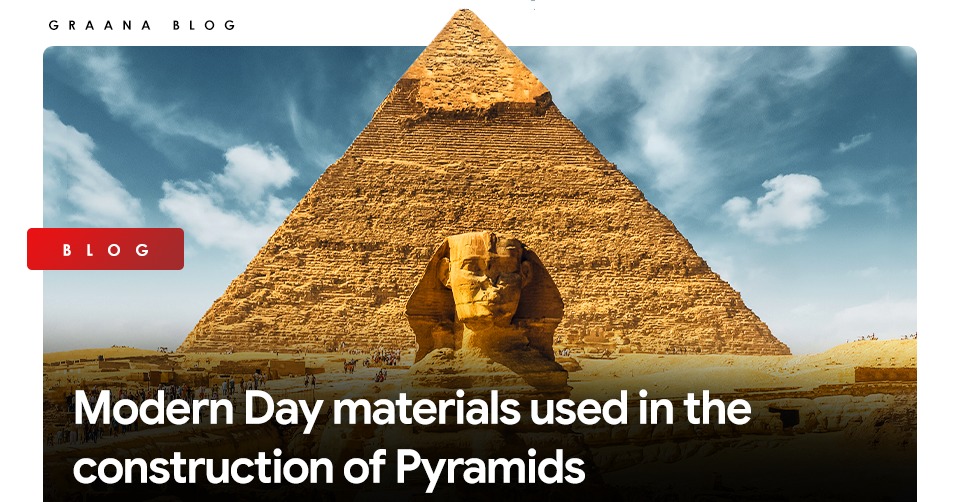One of the seven wonders of the ancient world – the Pyramids of Giza are a marvel of ancient architecture that have withstood the test of time, standing strong after nearly 4500 years. These Pyramids symbolise ancient Egypt’s prosperity and advanced knowledge, as the process of building these vast monuments still lies a mystery among the archaeological community.
However, the materials that were used to construct the pyramids have been deciphered and studied in detail, with some of them being as common as everyday modern building materials. Graana.com features an in-depth analysis of all the modern-day materials used in the construction of Pyramids.
A Glance at History

The Pyramids of Giza are monumental tombs from the Old Kingdom era of Egypt. These vast monuments were built around 2550 to 2459 BC. The notion behind erecting these vast structures was that once the Egyptian Pharaohs die, they become gods in the afterlife. The pyramids were supposed to serve as their temples, filled with the luxuries and goods that they would need to sustain themselves in the next life.
The Pyramids of Giza consist of three pyramids, each built by a separate Pharaoh. The first and largest pyramid was constructed by Pharaoh Khufu, while the second one was built by his son, Pharaoh Khafre. The third and smallest pyramid was constructed by Pharaoh Menkaure. All three pyramids are part of a massive complex that includes a temple, a palace, and other features.
Materials used in the construction of Pyramids
After thorough research and evaluation, archaeologists were able to discern the materials used in the construction of pyramids. Following are the modern-day materials that were used in making these monumental structures.
Limestone

Being one of the most readily available construction materials, it comes with no surprise that limestone was used in the construction of the Pyramids. This material is easy to extract, cut, and polish, making it a widely used construction material.
However, the quality of the limestone differed depending on its use. Low-grade limestone was used as one of the foundation materials for the pyramids, while the finer-quality limestone was simply used as a coating for the interior and exterior walls. Apart from being used as a core material, limestone was also used as a decorative material for the inner galleries.
Granite

Another commonly used construction material – granite served as decorative material as it was used to partially cover the outsides of the pyramids. Moreover, granite was also used to cover the interior walls of the pyramids. However, this material was sparingly used as most of Egypt’s granite was located in its southern region. Transporting materials through hundreds of miles was quite an inconvenience at that time, making granite’s use minimal.
Sandstone

Being a fragile material, sandstone’s uses were quite limited. However, some traces of the material have been found in the funeral complexes within the pyramids. Sandstone is a delicate material that is formed by the pressure of the layers of sand above. The material can be easily carved, giving way to eloquent and sophisticated designs. Today, sandstone serves as a commonly used sand for construction.
Syenite

Syenite is a rare material, seemingly similar to granite but with a few stark differences. During ancient times, the material was considered quite valuable as it was transported over long distances through boats from the south of the country. The material was used in making durable and firm blocks that were placed above the Pharaoh’s chamber.
Raw Brick

This material was used for the construction of the funeral complexes within the pyramids. As raw bricks are simple blocks of dried clay, the material can become quite fragile over time, making it ineffective for a sturdy structure. However, if used correctly, there are several uses for clay in modern-day construction.
Basalt

Basalt, also known as alabaster, was readily used as a flooring material for the pyramids. Made out of gypsum or calcite, this material was extracted from underground deposits and exposed pits. This material can also be found on the top of the pyramids, where it is used as a core material for the immaculate covers.
Despite being an ancient mystery, scientists have been able to discern the materials used in the construction of Pyramids, with most of the materials being similar to modern-day construction materials. The striking similarity in construction materials despite being 4500 years apart is a testament to the advanced knowledge and information that ancient Egypt held. For more information, visit Graana.com – Pakistan’s first online real estate market.




